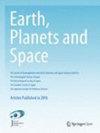Anatomy of thermal unrest at a hydrothermal system: case study of the 2021–2022 crisis at Vulcano
IF 2.5
3区 地球科学
引用次数: 0
Abstract
Abstract Hydrothermal systems can generate phreatic and/or phreatomagmatic explosions with little warning. Understanding the temporal and spatial evolution of geophysical and geochemical signals at hydrothermal systems is crucial for detecting precursory signs to unrest and to inform on hazard. Thermal signatures of such systems are poorly defined because data records are often too short or discrete compared to activity timescales, which can be decadal. La Fossa system of Vulcano has been monitored since the 1980s and entered a period of unrest in 2021. We assessed the thermal signature of La Fossa using ground- and satellite-based data with various temporal and spatial scales. While continuously-recording stations provided continuous but point-based measurements, fumarole field vent surveys and infrared images obtained from satellite-flown sensors (ASTER and VIIRS) allowed lower temporal resolution but synoptic records to be built. By integrating this multi-resolution data set, precursory signs of unrest could retrospectively be detected from February to June 2021. Intensity of all unrest metrics increased during summer 2021, with an onset over a few days in September 2021. By September, seismic, CO 2 , SO 2 and other geochemical metrics also indicated unrest, leading Civil Protection to raise the alert level to yellow on October 1. Heat flux, having been 4 MW in May 2019, increasing to 90 MW by September, and peaking at 120 MW in March 2022. We convolved our thermal data sets with all other monitoring data to validate a Vulcano Fossa Unrest Index (VFUI), framework of which can be potentially applied to any hydrothermal system. The VFUI highlighted four stages of unrest, none of which were clear in any single data set: background, precursory, onset and unrest. Onset was characterized by sudden release of fluids, likely caused by failure of sealed zones that had become pressurized during the precursory phase that began possibly as early as February 2021. Unrest has been ongoing for more than 18 months, and may continue for several more years. Our understanding of this system behavior has been due to hindsight, but demonstrates how multiparametric surveys can track and forecast unrest. Graphical Abstract热液系统热动荡的解剖:以Vulcano火山2021-2022年危机为例
热液系统可以在几乎没有预警的情况下产生潜水和/或潜水岩浆爆炸。了解热液系统的地球物理和地球化学信号的时空演变对于发现动荡的前兆信号和告知危险是至关重要的。这些系统的热特征定义不清,因为与活动时间尺度相比,数据记录往往太短或离散,可能是十年一次。自20世纪80年代以来,Vulcano的La Fossa系统一直受到监测,并于2021年进入动荡时期。我们利用不同时空尺度的地面和卫星数据评估了拉福萨的热特征。虽然连续记录站提供了连续但基于点的测量,但喷气孔现场喷口调查和卫星传感器(ASTER和VIIRS)获得的红外图像可以提供较低的时间分辨率,但可以建立天气记录。通过整合这一多分辨率数据集,可以追溯地发现2021年2月至6月期间的动荡前兆。2021年夏季,所有骚乱指标的强度都有所增加,并在2021年9月的几天内开始。到了9月,地震、二氧化碳、二氧化硫和其他地球化学指标也显示出动荡,导致民防部门在10月1日将警报级别提高到黄色。2019年5月的热通量为4兆瓦,到9月增加到90兆瓦,到2022年3月达到120兆瓦的峰值。我们将热数据集与所有其他监测数据进行卷积,以验证Vulcano Fossa动乱指数(VFUI),该框架可以潜在地应用于任何热液系统。VFUI强调了动荡的四个阶段,其中没有一个在任何单一数据集中都是明确的:背景、前兆、开始和动荡。爆发的特点是流体突然释放,可能是由于密封区域在可能早在2021年2月开始的前期阶段就已加压的密封区域失效所致。动乱已经持续了18个多月,可能还会持续几年。我们对这种系统行为的理解是由于后见之明,但证明了多参数调查如何跟踪和预测动荡。图形抽象
本文章由计算机程序翻译,如有差异,请以英文原文为准。
求助全文
约1分钟内获得全文
求助全文
来源期刊

Earth, Planets and Space
地学天文-地球科学综合
CiteScore
5.80
自引率
16.70%
发文量
167
期刊介绍:
Earth, Planets and Space (EPS) covers scientific articles in Earth and Planetary Sciences, particularly geomagnetism, aeronomy, space science, seismology, volcanology, geodesy, and planetary science. EPS also welcomes articles in new and interdisciplinary subjects, including instrumentations. Only new and original contents will be accepted for publication.
 求助内容:
求助内容: 应助结果提醒方式:
应助结果提醒方式:


